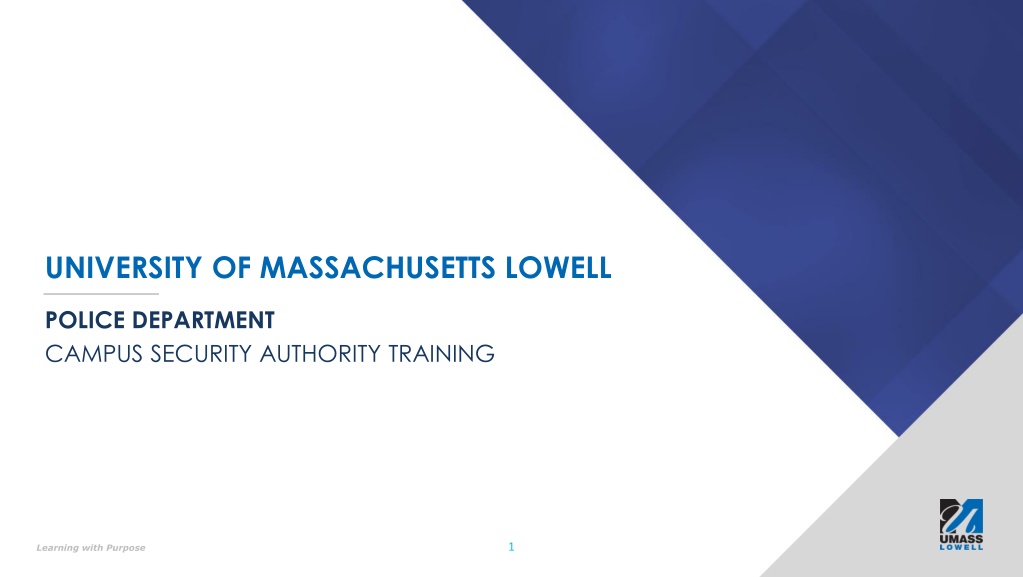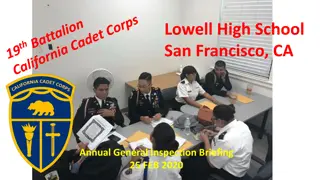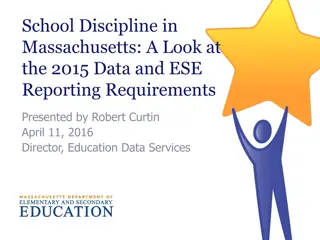UNIVERSITY OF MASSACHUSETTS LOWELL
Build a strong foundation and develop essential skills with the UMass Lowell Police Department Campus Security Authority Training program. Acquire the knowledge and expertise needed to ensure safety and security on campus. Enhance your understanding of campus security protocols, emergency response procedures, and crime prevention strategies. Join us to "Learn with Purpose" and make a positive impact in our university community.
Download Presentation

Please find below an Image/Link to download the presentation.
The content on the website is provided AS IS for your information and personal use only. It may not be sold, licensed, or shared on other websites without obtaining consent from the author.If you encounter any issues during the download, it is possible that the publisher has removed the file from their server.
You are allowed to download the files provided on this website for personal or commercial use, subject to the condition that they are used lawfully. All files are the property of their respective owners.
The content on the website is provided AS IS for your information and personal use only. It may not be sold, licensed, or shared on other websites without obtaining consent from the author.
E N D
Presentation Transcript
UNIVERSITY OF MASSACHUSETTS LOWELL POLICE DEPARTMENT CAMPUS SECURITY AUTHORITY TRAINING 1 Learning with Purpose
PRESENTED BY: Ronald Dickerson Deputy Chief, UMLPD 978-934-4202 Ronald_Dickerson@uml.edu Melissa Mullen Lieutenant, UMLPD 978-934-4212 Melissa_Mullen@uml.edu 2 Learning with Purpose
AGENDA UMASS LOWELL POLICE DEPARTMENT Introduction to the Clery Act Security on Campus, Inc. Clery Crimes Documenting Clery Act Geography CSA Designation/ Functions Policy Statements Questions/ Answers 3 Learning with Purpose
INTRODUCTION TO THE CLERY ACT Choosing a postsecondary institution is a major decision for students and their families. Along with academic, financial and geographic considerations, the issue of campus safety is a major concern. In order to ensure that campus crimes are reported, Congress enacted the Crime Awareness and Campus Security Act of 1990. The act requires all public and private institutions of postsecondary education participating in Federal student financial assistance programs to disclose campus crime statistics and security information to the public. The act was amended and renamed the Jeanne Clery Disclosure of Campus Security Policy and Campus Crime Statistics Act in 1998, in memory of Jeanne Clery. 4 Learning with Purpose
SECURITY ON CAMPUS INCORPORATED Jeanne Clery was a freshman when she was beaten, raped and murdered in her Lehigh University dorm room on 4/5/86. Jeanne s assailant was another Lehigh University student who murdered her during his attempt to commit robbery as she slept. Following the murder of their daughter, Connie and Howard Clery founded Security on Campus, Inc. (SOC), a non-profit organization dedicated to safe campuses for college and university students. SOC s mission is to prevent crime, violence and substance abuse on campuses and to compassionately assist the victims of these crimes. SOC has campaigned tirelessly to introduce legislation and to raise campus safety awareness. 5 Learning with Purpose
WHAT ARE THE CLERY ACT CRIMES? Criminal Offenses 1. Criminal Homicide, including: a. Murder and Non-negligent Manslaughter b. Negligent Manslaughter Sex Offenses, including: a. Forcible b. Non-forcible Robbery Aggravated Assault Burglary MV Theft Arson 2. 3. 4. 5. 6. 7. 6 Learning with Purpose
WHAT ARE THE CLERY ACT CRIMES? (CONT.) Hate Crimes (Crimes motivated by bias) 1. Any of the above-mentioned criminal offenses 2. Larceny/ Theft 3. Simple Assault 4. Intimidation 5. Destruction/ Damage/ Vandalism of Property 6 categories which must be reported: Race, Gender, Religion, Sexual Orientation, Ethnicity/ National Origin/ Disability * 7 Learning with Purpose
WHAT ARE CLERY ACT CRIMES? (CONT.) VAWA Offenses 1.) Domestic Violence 2.) Dating Violence 3.) Stalking *Note that Sexual Assault is also a VAWA Offense but it included in the Criminal Offenses category for Clery Act reporting purposes. 8 Learning with Purpose
WHAT ARE THE CLERY ACT CRIMES? (CONT.) Arrests and Referrals for Disciplinary Action for: 1. Weapons: (carrying, possessing, etc.) 2. Drug Abuse Violations 3. Liquor Law Violations * Referred for disciplinary action means the referral of any person to any official who initiates a disciplinary action of which a record is kept, and which may result in the imposition of a sanction. 9 Learning with Purpose
DOCUMENTING CLERY ACT CRIMES Statistics for all Clery Act crimes must be disclosed on the Annual Security Report (ASR) by the type of crime that was committed, the year in which the crime was reported and the geographic location where the crime occurred. 10 Learning with Purpose
CLERY ACT GEOGRAPHY: 1. On campus: Any building or property owned or controlled by the institution within the same reasonably contiguous geographic area. 2. On public property within or immediately adjacent to the campus: Property owned by a public entity, such as a city or state government, e.g., a public sidewalk that borders the campus or a public road that runs through your campus. 3. In or on non-campus buildings or property: Property that is not located on the campus but owned or controlled by the institution. 11 Learning with Purpose
CSA DESIGNATION A CSA is any official of the institution who has significant responsibility for the student and campus activities. These individuals include: The Dean of Students office The Director of Student Judicial Affairs The Office of Residence Life and their direct reports (RD s, ARD s, RA s) The Director of Athletics and their direct reports (coaches, asst. coaches) The Director of the Counseling Center The Director of Health Services The Director of Disability Services 12 Learning with Purpose
WHAT DOES A CSA DO? The function of a CSA is to report to the official or office designated by the institution to collect crime report information (UMLPD), those allegations of Clery Act crimes that he or she concludes were made in good faith. Voluntary Confidential Reporting allows any staff or faculty member who has knowledge that an offense has occurred in one of the Clery Act geographical areas to report the offense to the UMass Lowell Police without jeopardizing confidentiality or causing discomfort to the victim. 13 Learning with Purpose
WHAT A CSA DOES NOT DO? It is not the function of a CSA to: Apprehend the perpetrator Investigate an alleged crime Convince the victim to contact law enforcement These are functions of law enforcement. 14 Learning with Purpose
POLICY STATEMENTS Along with crime statistics, our ASR must include policy statements related to campus security that disclose what you do and how you do it. They must accurately reflect our current procedures and practices. These statements will include what programs and policies are in place for such things as: Campus law enforcement Procedures for students to report crimes on campus Security and access to campus facilities Crime prevention Drug and alcohol abuse prevention and treatment programs Emergency notification and timely warning policies Sex offense procedures and prevention programs Obtaining registered sex offender information Missing students 15 Learning with Purpose
QUESTIONS AND ANSWERS 16 Learning with Purpose






























